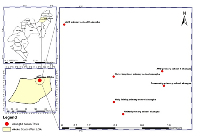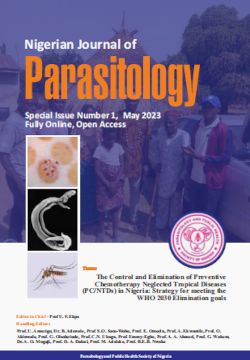Geohelminthiases: Soil Contamination and Associated Physicochemical Parameters favouring Ova Dispersion in Public Schools in Ondo State, Nigeria
DOI:
https://doi.org/10.4314/njpar.v45i1.23Keywords:
Public Schools, Transmission, Physicochemical parameters, Ova dispersion, GeohelminthiasesAbstract
Geohelminth infections are common diseases in sub-Saharan Africa and are a major contributor to setbacks in the socioeconomic and health status of people. This study assessed parasite ova/larvae dispersion in public schools and the associated physicochemical parameters in Akungba Akoko, Ondo Statestate, Nigeria. A total number of five hundred and sixteen (516) soil samples were collected from all the public primary schools (6) in the study area and examination was done in triplicate in all the primary schools in the community using standard procedures, a total of six thousand and twenty-eight (6,028) parasites were recovered after laboratory analyses; hookworm larvae n=2210 (36.66%), followed by Trichuris trichiura n=1572 (26.08%), hookworm ova, n= 1001 (16.61%), Strongyloides stercoralis ova, n= 636 (10.55%) and Ascaris lumbricoides ova, n= 600 (9.95%). The physico-chemical parameters of soil samples at different cardinal points within and around the study area revealed the highest pH (7.82 and the highest electrical conductivity (612.54mS/cm, soil temperature ranged from 22.61 and 26.08 and the highest total dissolved solid was 337.72ppm. Correlation analyses carried out on the recovered parasites with physicochemical parameters revealed that hookworm larvae showed a positive correlation with temperature, with a weak negative correlation with electrical conductivity and total dissolved solids, and Trichuris trichiura had a significant negative correlation with pH and total dissolved solids. The other parasites also showed varying correlations with the physicochemical parameters. Based on these findings, environmental modifications are recommended as an effective preventive measure. Harnessing the results of the physicochemical parameters in relation to the parasites, mass chemotherapy of schoolchildren, health education campaigns, improved sanitary conditions, provision of toilet facilities, and personal hygiene are equally recommended.
References
Phuphisut, O., Yoonuan, T., Sanguankiat, S., Chaisiri, K., Maipanich, W., Pubampen, S. and Adisakwattana, P.(2014). Triplex polymerase chain reaction assay for detection of major soil-transmitted helminths, Ascaris lumbricoides, Trichuris trichiura, Necator americanus, in faecal samples. Southeast Asian Journal of Tropical Medicine and Public Health, 45(2): 267-275. https://pubmed.ncbi.nlm.nih.gov/24968666/
Hassan, A. A. and Oyebamiji, D. A. (2018) Intensity of soil-transmitted helminths in relation to soil profile in selected public schools in Ibadan Metropolis. Biometrics and Biostatistics International Journal,7(15): 413-417. DOI: 10.15406/bbij.2018.07.00239
Oniya, M. O. (2019). Soil Contamination as an Indicator of Geohelminthiasis in Primary Schools in Ibarapa East Local Government Area of Oyo State. Global Journal of Medical Research, 19(5):18-19. https://medicalresearchjournal.org/index.php/GJMR/article/view/1795/4-Soil-Contamination-as-an-Indicator_JATS_NLM_xml
World Health Organization (2019). World Health Organization. Soil-Transmitted Helminth Infections. Key Facts. WHO, Geneva. Wiley & Sons, Inc. UK: 368pp. https://www.who.int/news-room/factsheets/detail/soil-transmitted-helminthinfections
Bismarck, N., Payne, V., Cedric, Y. and Nadia, N. A. C. (2020). Gastro-intestinal helminth infections and associated risk factors amongst school aged children in Kouoptamo Noun Division, West Region, Cameroon. International Archives of Public Health and Community Medicine, 4: 39.
DOI: 10.23937/2643-4512/1710039
Bethony J., Brooker S., Albonica M., Geiger S. M., Loukas A., Diemert D., and Hotez P. J. (2006), Soil-transmitted helminth infections: ascariasis, trichuriasis and hookworm. Lancet, 367(9521):1521–32. DOI: 10.1016/S0140-6736(06)68653-4
Ojha, S. C., Jaide, C., Jinawath, N., Rotjanapan, P. and Baral, P. (2014). Geohelminths: public health significance. The Journal of Infection in Developing Countries, 8(1): 5-16. DOI: 10.3855/jidc.3183
Pham-Duc, P., Nguyen-Viet, H.,Hattendorf, J., Zinsstag, J., Phung-Dac, C., Zurbrügg, C. and Odermatt, P. (2013). Ascaris lumbricoides and Trichuristrichiura infections associated with wastewater and human excreta use in agriculture in Vietnam. Parasitology International, 62(2): 172-180. DOI:10.1016/j.parint.2012.12.007.
Gyorkos, T. W., Maheu-Giroux, M.,Blouin, B. and Casapia, M. (2013). Impact of health education on soil-transmitted helminth infections in schoolchildren of the Peruvian Amazon: a cluster-randomized controlled trial. PLoS Neglected Tropical Diseases, 7(9): 2397. DOI:10.1371/journal.pntd.0002397
Akinseye, F. J., Egbebi, A. O. and Fadare, O. S. (2017). Challenges of soil-transmitted Helminthiasis in some communities in Ondo state, Nigeria. Annals of Parasitology,65(2): 131-139. DOI: 10.22192/ijarbs.2017.04.03.019
Oniya, M. O., Kareem O. I., and Afolabi O. J. (2023). Health implications ofpatronage of open markets: A survey of Shasha market, Oba-Ile, Akure, Ondo State, Nigeria. Journal of Public Health and Epidemiology, 15(1): 10-21. DOI:10.5897/JPHE2022.1393
Oniya, M. O., Dare, T. I., Omotunwase, O. I., Simon-Oke, I. A. and Onagbola, E. O.(2023) Wash Deployment and Geo-helminth Ova Dispersion in Primary Schools in Akure North and Owo Local Government Areas, Ondo State, Nigeria. International Journal of Innovative Research and Development, 12 (4): 30-36. DOI:10.24940/ijird/2023/v12/i4/APR23001
Zajac, A. M. and Conboy, G. A. (2012). Veterinary Clinical Parasitology EighthEdition. John Wiley & Sons Ltd, West Sussex, UK: 368pp.
https://www.wiley.com/en-dk/Veterinary+Clinical+Parasitology%2C+8th+Edition-p-9780813820538
Chiodini, P. L., Moody, A. H. and Menser, D. W. (2003). Atlas of MedicalHelminthology and Protozoology, 4: 4-13. https://www.academia.edu/29239471/Chiodini_Atlas_of_Medical_Helminthology_and_Protozoology
Dada, E. O. and Egbunu, A. A. (2016) Dispersion of human intestinal geohelminths in selected refuse dumpsites in Igbara-oke, Ifedore Local Government Area, Ondo State, Nigeria. International Journal of Current Microbiology and Applied Science, 5(4): 924-928. DOI:
http://dx.doi.org/10.20546/ijcmas.2016.504.104
Brooker, S., Clements, A. and Bundy, D.(2006). Global Epidemiology, Ecology and Control of Soil-Transmitted Helminth Infection. Advances in Parasitology, 62:221-261. DOI: 10.1016/S0065-308X(05)62007-6
Allen, A. A. (2018). Healthy Living and Environmental Sanitation Practices inAkungba-Akoko, Nigeria: Issues And Challenges. Annals of the University of Oradea, Geography Series/Analele Universitatii din Oradea, Seria Geografie, 28(2). 222-230. https://www.europub.co.uk/articles/healthy-living-and-environmental-sanitationpractices-in-akungba-akoko-nigeria-issuesand-challenges-A-503328
Amadi, E. C and Uttah, E. C. (2010). Impact of Physico-Chemical Factors of Contaminated Foci on the Survival of Geohelminths in Abua Communities, Niger Delta Nigeria. Journal of Applied Science and Environmental Management, 14(2): 61-64. DOI:10.4314/jasem.v14i4.63283
Owhoeli, O., Imafidor, H. and AwiWaadu, G. D. B. (2017). Assessment of Physico-Chemical Parameters of Soils in Fallowing Farmland and Pit Toilet Environment as it Affects the Abundance of Geohelminths in Emohua Local Government Area, Rivers State, Nigeria. Annual Re s earch and Review in Biology, 14(3): 1-10. DOI: 10.9734/ARRB/2017/31546
Oyewole, O. E., and Simon Oke I. A. (2022). Ecological risk factors of SoilTransmitted Helminths infections in Ifedore district, Southwest Nigeria. Bulletin of the National Research Centre, 46(1): 13. DOI: 10.1186/s42269-022-00700-8
Etewa, S. E., Abdel-Rahman, S. A., Abd El-Aal, N. F., Fathy, G. M., El-Shafey, M. A. and Ewis, A. M. (2014). Geohelminths distribution as affected by soil properties, physicochemical factors and climate in Sharkyia governorate Egypt. Journal of Parasitic Diseases, 40(2):496–504. DOI: 10.1007/s12639-014-0532-5.
Letah Nzouebet, W. A., Kengne Noumsi, I. M. and Rechenburg. A. (2016) Prevalence and diversity of intestinal helminth eggs in pit latrine sludge of a tropical urban area. Journal of Water, Sanitation and Hygiene Development, 6(4):622–630. DOI:10.2166/washdev.2016.074
Muntalif, B. S., Firdayati, M., Lesmono, F.D., Siregar, A. S., Notodarmojo, P. A. and Fathuna, I. S. (2020). Helminth eggs assessment of faecal sludge in urban area of Bandung, Indonesia. E3S web ofconferences, 48: EDP Sci, p 4002.https://www.e3sconferences.org/articles/e3sconf/abs/2020/08/e3sconf_etmc2020_04002/e3sconf_etmc2020_04002.html
Simon-Oke, I. A. (2020). Evaluation of Health Risk in Relation to Geohelminths in Dumpsites of Ondo Town, Nigeria.European Journal of Biological Research, 10(3):251-25. DOI: 10.5281/zenodo.3969551

Downloads
Published
How to Cite
Issue
Section
License
Copyright (c) 2024 Nigerian Journal of Parasitology

This work is licensed under a Creative Commons Attribution-NonCommercial-NoDerivatives 4.0 International License.




